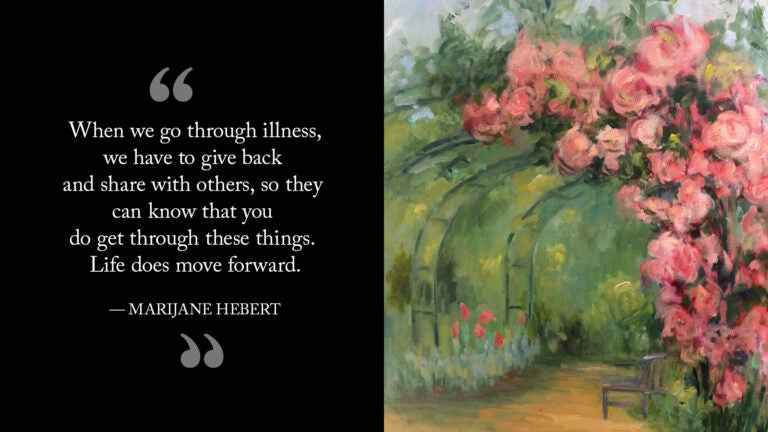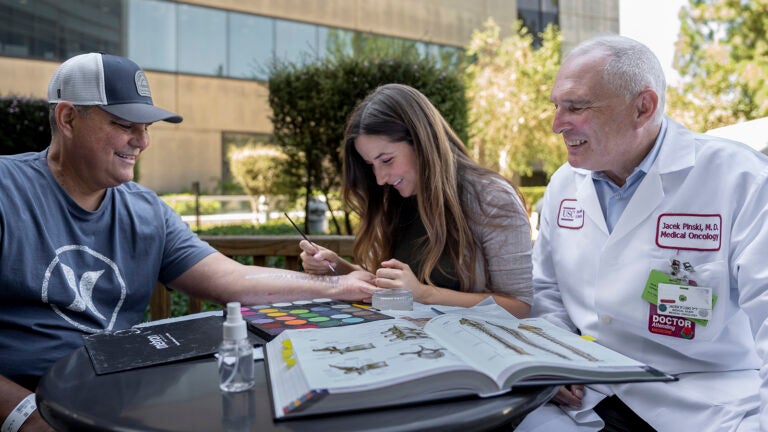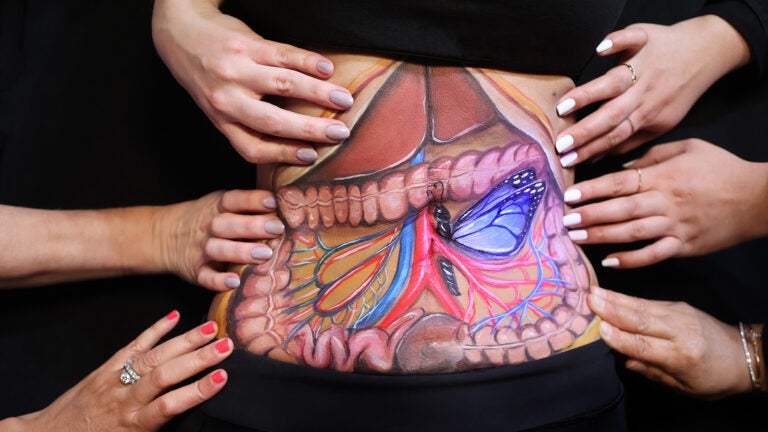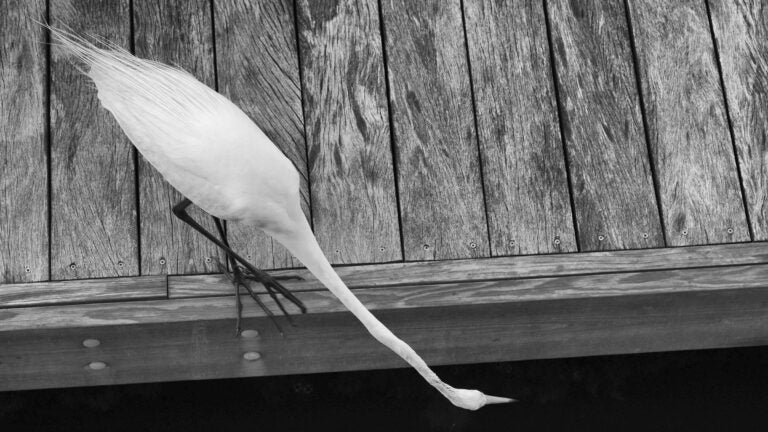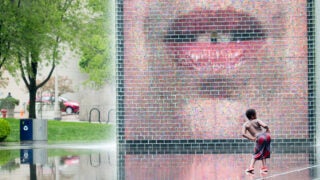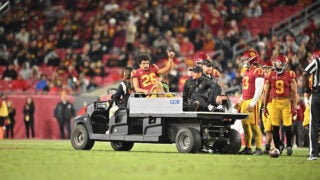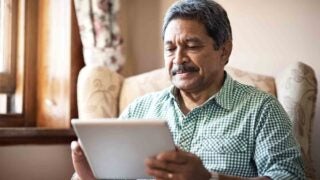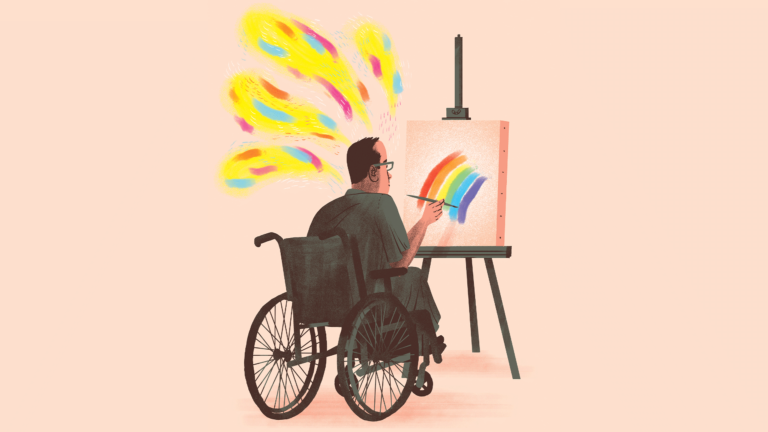
(Illustrations by Paul Blow)
Using art for medical healing
A vibrant collection of USC programs infuses arts activities into health care to soften the hospital setting, support patients’ recovery and lift their spirits.
In the USC-Verdugo Hills Hospital (USC-VHH) Breast Healthcare Center, an exhibit of oil paintings adorns the walls next to the 3D mammography machine. Each artwork depicts a stunning natural scene: Wildflower-studded cliffs framing an azure sea. A footbridge arching over a tranquil pond. Glass vases brimming with irises and sunflowers.
A cancer screening room may seem an unlikely venue for a gallery display. But the artist, Marijane Hebert, sought the opportunity to show her work here. A two-time breast cancer survivor and patient of the USC-VHH Breast Healthcare Center, Hebert knows firsthand how nerve-racking it can be to undergo breast cancer screening — and how art can be a refuge during diagnosis and treatment.
“When you hear the word ‘cancer,’ it’s very frightening,” says Hebert, 85, a La Cañada Flintridge resident who has exhibited in galleries in the United States and Europe. “I just thought that art would be fabulous to have in the Breast Healthcare Center to help create a calming atmosphere.”
Hebert’s exhibit was made possible by the USC-VHH Healing Arts Program, which mounts permanent and rotating exhibits by local artists in the hospital’s hallways and treatment spaces. Supported by the Sue and Steve Wilder Healing Arts Endowment, the program also allows hospitalized patients to select a work of their choice from a roving “Art Cart” to keep in their room during their stay and to take home.
“We focus on fine art reflecting positive images of nature and familiar scenery,” says Julie Shadpa, an art therapist by training who is co-chair of the Healing Arts Program and director of donor programs and strategic outreach for the USC-VHH Foundation. “Research has indicated that such imagery lowers stress and distracts from pain. … It gives people a sense of place and connection in the hospital environment, which can be stressful and unfamiliar.”
Art has been used as an adjunct to medical treatment since ancient times. But in the past few decades, a growing body of research has confirmed that viewing and creating art can benefit patients’ physical and mental well-being. The Healing Arts Program is among a robust collection of USC programs that combines the arts with medicine in creative and evidence-based ways to comfort patients and support their healing.
Fighting cancer with creativity
At the Institute for Arts in Medicine (I_AM) at the USC Norris Comprehensive Cancer Center, a wide range of expressive arts programming aims to improve clinical outcomes for patients.
In the Creative Corner, a cheerful arts studio in the hospital, patients can try their hand at fun projects like painting rocks with inspirational sayings or personalizing a hospital wristband. On Zoom, they can join poetry-writing workshops. From their hospital rooms, they can write, sing and record an original song with the help of a songwriter. In the Rare Book Room at the USC Norris Medical Library, they can plan a body painting session with artist-in-residence Savannah Mohacsi, who draws inspiration from archaic medical illustrations. She later turns the region of the body that is ailing the patient into a creative canvas.
“Creative interventions such as music, poetry and painting can significantly decrease anxiety, depression and a lot of the negative psychological aspects associated with cancer and its treatment,” says Jacek Pinski, associate professor of medicine in the division of medical oncology at USC Norris and executive clinical director of I_AM. “The immune system, which plays a critical role in fighting cancer, gets boosted by these interventions,” he adds.
We call ourselves ‘I_AM’ for a reason: We believe that creative expression brings people closer to their true identities.
— Genevieve “Viva” Nelson
Patients can also don virtual reality (VR) goggles to engage with artistic renderings of natural settings like waterfalls and beaches. Pinski and the I_AM team are currently conducting a clinical trial evaluating the impact of these VR experiences on pain and anxiety during painful bone marrow biopsies.
Yet data doesn’t easily capture some of the most impactful aspects of I_AM’s arts programming. The activities allow patients to reflect on their experiences with illness, integrate them into their larger life journeys and glean wisdom that fortifies them through ongoing challenges.
“We call ourselves ‘I_AM’ for a reason: We believe that creative expression brings people closer to their true identities,” says Genevieve “Viva” Nelson ’18 (SCA), the creative director and co-founder of I_AM. “Engaging with the arts and engaging with our team allows patients to recognize their importance and their value and connect to their extraordinary capacity to be creative.”
Clowning around
Twice a week, children at Los Angeles General Medical Center receive a visit from specially trained USC staff. These visitors aren’t wearing white lab coats or surgical scrubs — they’re sporting red noses and ridiculous costumes. They play ukuleles, blow bubbles, juggle scarves and devise silly scenarios.
They’re medical clowns from USC Comic+Care, a program at the USC School of Dramatic Arts that employs comedic arts to support children grappling with illness.
Both disease symptoms and the hospital environment itself can dim children’s natural propensity for creative play. “You are given a [hospital] gown and put into a room that is completely unfamiliar to you and rather sterile,” says Zachary Steel, assistant professor of theater practice at the USC School of Dramatic Arts and director of USC Comic+Care. “We are trying to reframe the hospital visit into something with the potential for joy and play.”
The laughter that the clowns spark is medicine of its own. Research has shown that laughter can do everything from boosting immune and endocrine responses to decreasing blood pressure and feelings of despair. USC Comic+Care is currently partnering with the hospital’s pediatric oncology and hematology clinic to conduct a study on the effect of clowning on children’s pain perception and levels of stress and anxiety during blood draws.
Steel is also training the next generation of medical clowns. He teaches introductory and advanced medical clowning, the latter offering USC undergraduates the opportunity to do some clowning of their own with the children at Los Angeles General Medical Center.
“It’s beautiful when you hear the children’s laughter,” Steel says. “It’s a recognition of, ‘I still have the capacity for joy. I can still play. I’m still a kid.’”
Waltzing toward better health
Older adults, too, can benefit from the lightheartedness that arts activities inspire. Dance is one example: The art of movement offers neurological, social and emotional benefits to those struggling with neurodegenerative diseases such as Parkinson’s disease.
“Dance can trick our brains into working better,” says Patrick Corbin, associate professor of practice at the USC Kaufman School of Dance. Research has shown that Parkinson’s patients who participate in dance have improved speech, fewer tremors, better balance, decreased rigidity and slower disease progression compared to those who do not.
Creative interventions such as music, poetry and painting can significantly decrease anxiety, depression and a lot of the negative psychological aspects associated with cancer and its treatment.
— Jacek Pinski
Corbin teaches “Dance and Health: Dance and Parkinson’s,” an undergraduate course that combines movement instruction with guest lectures from experts in a variety of health science disciplines, including the Department of Neurology at the Keck School of Medicine of USC, the USC Mrs. T.H. Chan Division of Occupational Science and Occupational Therapy at the Herman Ostrow School of Dentistry of USC, and the USC Leonard Davis School of Gerontology.
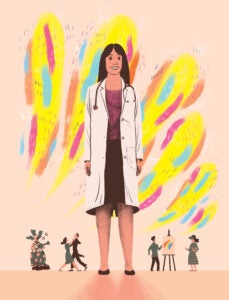
Students put that knowledge into action through fieldwork in the community. They observe and participate in dance classes for Parkinson’s patients taught at Lineage Performing Arts Center in Pasadena, Calif., a partner of the Keck School of Medicine. For their final exam, students teach a segment of the Lineage class on their own.
The “Dance and Health: Dance and Parkinson’s” class is part of a series of adaptive dance classes that Corbin conceived and developed with the support of Arts in Action, part of USC Visions and Voices. In fall 2023, his class focused on Down syndrome and brought dancers from Free 2 Be Me Dance — an organization that serves people with Down Syndrome — to USC Kaufman for instruction. Another course for children with autism spectrum disorders is in the works. Corbin praises his collaborators in USC’s health sciences schools who are helping him illuminate the power of dance to influence the well-being of marginalized communities.
“These wonderful doctors are really seeing the scientific value of the connection between the arts and sciences,” Corbin says. “I think we’re just at the beginning of creating a world where better lives are accessible to people who may have been overlooked before.”
Healthier together
Building new partnerships between USC’s health sciences and arts schools is a priority for Josh Kun, vice provost for the arts. In March, he and Michele Kipke, associate vice president for strategic health alliances at the Keck School of Medicine of USC, led a daylong retreat for deans and faculty to spark new research collaborations between the arts and health sciences. Their efforts reflect USC President Carol Folt’s “moonshot” on transforming health sciences, which seeks to expand health sciences work across the university.
Kun notes that among their many benefits, USC’s varied arts in medicine programs provide patients an antidote to the isolation of illness.
“When we hear a song, when we watch a dance performance, when we watch a film, when we look at a painting or a sculpture, one of the things that can happen is you realize you are not alone,” Kun says. “Somebody else’s experience touches your own life.”
Hebert — who, in addition to her permanent exhibit in the USC-VHH Breast Healthcare Center, has an exhibit on display in the main USC-VHH building through June — echoes his sentiments.
“When we go through illness, we have to give back and share with others, so they can know that you do get through these things,” she says. “Life does move forward.”

